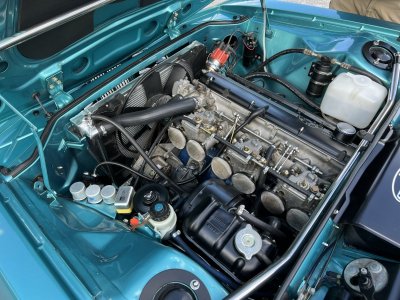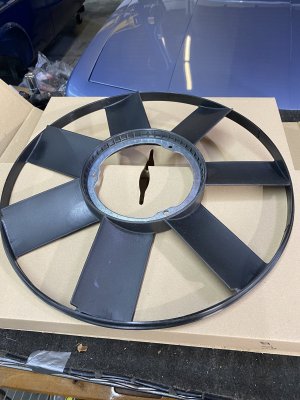I like the whole triple Weber thing, but it’s not for everyone.
I have the Korman intake manifold and tstat housing in my car. Korman no longer sells the manifold (I talked to Ray Korman about this at Legends/Hilton Head last fall; his supplier lost the molds and drawings in a fire), but they are willing to make up a tstat housing. There is no one stop shop for all the parts necessary to do a triple Weber setup.
Benefits:
Tuning is very flexible.
- You can tune for maximum horsepower (which is what the race versions of our car did) or for driveability or for a range of possibilities in between.
- You can tune for your particular circumstances (type of fuel, elevation above sea level, etc.)
- You have a throat for each cylinder, which means you can refine your tune to take into account variability from cylinder to cylinder.
- You can tune to take into account fuel economy, or not.
- You can tune to take into account emissions, or not.
They sound fabulous, and their sound is unique.
They look great.
They are purely a vintage car thing; there is no modern analog.
Disadvantages:
While they can complement other engine improvements, on a stock engine, they offer only modest improvements in performance and then only if well tuned.
There is not an abundance of people who can work on them for you. And because triple Webers were not a factory option on our cars, there are no reference materials on how to tune them. If you don’t learn to tune them yourself, you need to find an old school mechanic (and one who is willing to work on your setup, which some will not be).
Because they are so flexible, they can also be complicated to tune. This fact also complicates hiring someone to work on them because they may have different ideas on how to tune them (e.g., they may place more emphasis on fuel economy, whereas you might prefer more top end horsepower).
They are expensive to acquire.
In our cars, there are a number of changes that must be made to make the carbs fit:
- the mechanical fuel pump needs to be changed for an electric fuel pump
- the carbs require a unique intake manifold
- the carbs require a unique linkage from the bell crank up and across the carbs
- the front carb will be really really close to your tstat housing; best to either obtain a modified housing (which Korman sells) or get an offset block like the one Markos made a few years back
- air cleaner options are limited, and many don’t look good in our cars. In addition, the brake booster interferes with most air cleaners on the middle carb. Changing to a tii booster is recommended because of this.
They do not self adjust. If you go into the mountains, for example, your car will run rich in the thinner air, and you need to change jetting to address this.
The accelerator pump circuits dump fuel into the carbs whenever you step on the gas. While this is somewhat adjustable, it wastes fuel and can increase emissions. This is the primary area where fuel injection is better than carbs because the amount of fuel supplied upon acceleration is much more tightly controlled.
Carbs can be made to run almost as efficiently as fuel injection when the car is up to operating temperature, but no matter how much you try, carbs emit more emissions when the engine is cold. (This is why carbs are no longer used on automobiles.)
While they are robust, they require regular monitoring, as there are numerous ways in which they can go out of tune. I just had one of the floats in one of my carbs take on gasoline so that it no longer floated properly. Vacuum leaks, not only on the carbs themselves but also on ancillary systems like the brake booster and distributor vacuum advance circuit, are another area of concern. Quite simply, they are not as carefree as fuel injection, so you have to really want them in your car else the hassle is not worth it.




